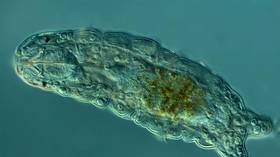Scientists blast ‘invincible’ tardigrades to test limits of organic life in outer space

To test the theoretical limits for cosmic punishment that extraterrestrial life might be able to endure, scientists recently took the toughest creature known to humanity and blasted it out of a high-powered gun in their lab.
Tardigrades, sometimes known as water bears, are microscopic invertebrates found on land and in the oceans. Humanity may also have recently sent them to the Moon on board the crashed Israeli spacecraft Beresheet.
Also on rt.com Did Israel colonize the Moon? Near-invincible ‘water bears’ may have SURVIVED lunar probe crashTardigrades can dry themselves out and effectively put themselves in stasis for extraordinarily long periods of time, up to several years in some instances, through a process known as desiccation.
They can also withstand freezing temperatures or boiling waters, extremely high pressure or the vacuum of space, zero oxygen and even exposure to cosmic radiation.
Astrochemist Alejandra Traspas and astrophysicist Mark Burchell from the University of Kent set out to discover just how much punishment these microscopic creatures can endure.
While their experiment, involving firing the tiny tardigrades from a two-stage, light-gas gun at speeds of up to eight kilometers per second (five miles per second) might seem cruel, the researchers wanted to test the limits of panspermia, or the spread of life throughout the universe on board asteroids and comets.
They froze groups of freshwater tardigrades from the Hypsibius dujardini species to induce their hibernation ability before firing them at sand targets contained within a vacuum chamber in their laboratory at velocities between 0.556 and 1.00 kilometers per second.
The tardigrades were then extracted from the sand targets by submerging them in water. A control group of 20 tardigrades were frozen but not blasted out of the gun, so the researchers could compare how quickly each group came out of hibernation.
In the case of the unblasted group, the process of reanimation took roughly eight or nine hours.
Also on rt.com Defrosted tiny animals come back to life, breed after 30 years in freezerMeanwhile, the blasted tardigrades, having survived an impact velocity of up to 825 meters per second, understandably took longer to recover. Tardigrades who were fired at the targets at the next highest velocity, 901 meters per second, disintegrated on impact.
The study didn’t directly answer the question of whether the tardigrades on board the crashed Israeli Beresheet spacecraft survived or not, but the final data sent by the probe indicated vertical and horizontal velocity of 134.3 m/sec and 946.7 m/sec respectively.
“That complex structures undergo damage in shock events is not a surprise,” the researchers wrote. “The peculiarity here may be that recovery and survival is still possible until just before the impact events begin to break the tardigrades apart.”
In other words, it is possible that tardigrades may survive ferocious impacts on the moons orbiting Earth and other planets within our solar system. However, they would need to be extremely lucky, striking their new home at just the right angle and coming to rest in a position shielded from cosmic radiation and other elements which might interfere with their recovery process.
The researchers will continue to study the long-term survivability of the blasted tardigrades to assess the lasting effects of being fired out of a gun on one of the hardiest species known to mankind.
Like this story? Share it with a friend!















